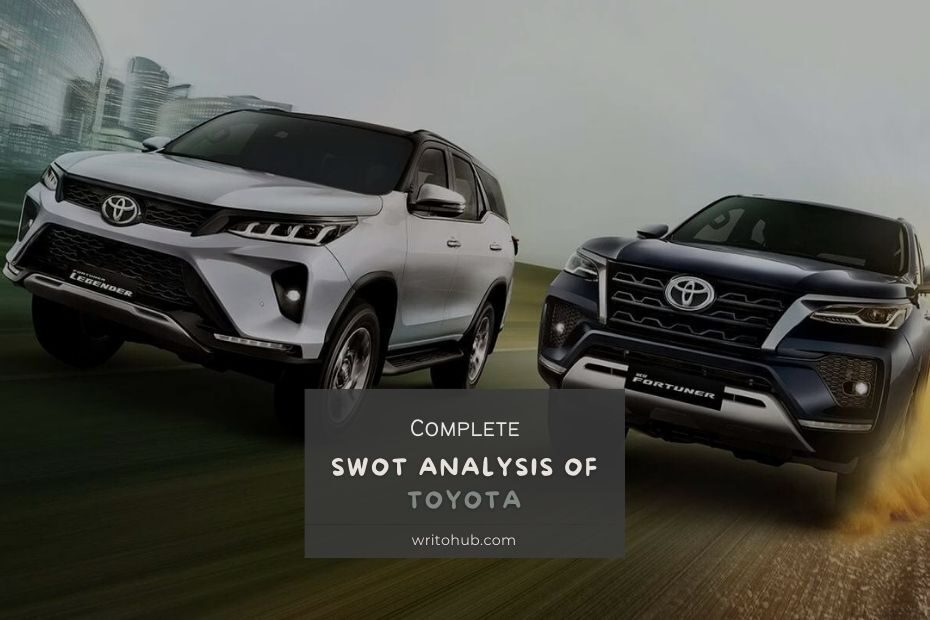The SWOT Analysis of Toyota tells the SWOT (Strengths, Weaknesses, Opportunities, and Threats) of the Japanese multinational automotive manufacturer – Toyota!
Toyota, an automotive company, has earned its place as one of the world’s largest and most respected automakers.
A comprehensive SWOT analysis of Toyota reveals its strengths, weaknesses, opportunities, and threats, offering insights into its strategic position in the dynamic automotive market.
Marketing Mix – Click here to read the Marketing Mix of Toyota
Strengths in the SWOT Analysis of Toyota
- Strong Brand Reputation: Toyota is known for its reputation for quality, durability, and reliability, earning the trust of consumers worldwide.
- Diverse Product Portfolio: Toyota offers a diverse range of vehicles, including cars, trucks, SUVs, and hybrids, catering to various consumer segments.
- Global Presence: Toyota operates in numerous countries, with a strong international presence, allowing it to tap into diverse markets.
- Innovation and Technology: Toyota invests heavily in research and development, pioneering hybrid technology with the Prius and exploring electric and autonomous vehicles.
- Lean Manufacturing: Toyota’s renowned production system focuses on efficiency, cost reduction, and waste minimization, enhancing profitability.
Weaknesses in the SWOT Analysis of Toyota
- Recall and Quality Issues: Toyota has faced recalls and quality-related concerns in the past, impacting brand perception and trust.
- Environmental Regulations: Stricter emissions regulations can affect Toyota’s ability to produce vehicles with specific technologies.
- Dependency on North America: A significant portion of Toyota’s revenue comes from North America, making it vulnerable to regional economic fluctuations.
- Market Share Competition: Toyota competes with other well-established automakers, each striving to offer unique features and driving experiences.
- Limited Electric Vehicle Presence: While Toyota has pioneered hybrid technology, its all-electric vehicle (EV) offerings are relatively limited compared to some competitors.
Opportunities in the SWOT Analysis of Toyota
- Electric and Hybrid Vehicles: Expanding the hybrid and electric vehicle lineup can align Toyota with the trend toward sustainable mobility.
- Global Expansion: Exploring emerging markets and increasing presence in regions with growing demand for vehicles can boost sales.
- Advanced Driver Assistance: Developing and enhancing advanced driver assistance systems and autonomous driving features can appeal to safety-conscious consumers.
- Digital Transformation: Enhancing digital connectivity, infotainment systems, and AI-driven features can attract tech-savvy consumers.
- Sustainability Initiatives: Focusing on sustainability practices, such as reducing emissions and incorporating renewable materials, aligns with evolving consumer preferences.
Threats in the SWOT Analysis of Toyota
- Intense Competition: Toyota faces competition from established automakers, electric vehicle manufacturers, and tech companies entering the automotive sector.
- Economic Volatility: Economic downturns can impact vehicle sales as consumer spending on discretionary items decreases.
- Regulatory Changes: Evolving emissions regulations and safety standards can impact Toyota’s ability to produce vehicles with specific technologies.
- Supply Chain Disruptions: Disruptions in the supply chain, such as semiconductor shortages, can affect production and delivery times.
- Cybersecurity Risks: As vehicles become more connected, the threat of cybersecurity breaches and data privacy concerns could impact customer trust.
Conclusion
Toyota’s SWOT analysis underscores its position as a respected global automotive manufacturer, leveraging strengths to address weaknesses, seize opportunities, and mitigate threats.
The company’s ability to innovate, adapt to changing market dynamics, and lead in sustainable and advanced automotive technologies will determine its continued success in the competitive automotive industry.
